*** This cache is part of the Taking Flight GeoTour. Anyone can claim this cache, but to be eligible to receive a Taking Flight GeoTour prize tag, geocachers must complete the activities in this survey for at least 12 caches on the tour.***
Did you know that each day Florida is visited by aliens? As you read this cache description, Florida is being invaded! We’re not talking about space aliens, though, but these invaders can do just as much damage. The aliens we see regularly in Florida are exotic plants and animals that are not part of the natural landscape. These exotic invasive species are introduced to the habitat, either intentionally or accidentally, and can have an extremely negative impact on the environment. An invasive species can take over habitat and resources from native wildlife and plants, out-competing the natives for food, water, shelter, and space. In some cases, they may even eat the native species and impact the population by preying upon the locals. Invasive plants and animals can alter the food web. When they crowd out other native plants or animals the creatures that rely on that particular native species may not be able to feed off of the invasive threatenting their survival. Because the invasives are exotics there are usually no ecological “checks” on them, like predator insects or animals that would eat them, and they often can grow unchecked and quickly overtake an area.
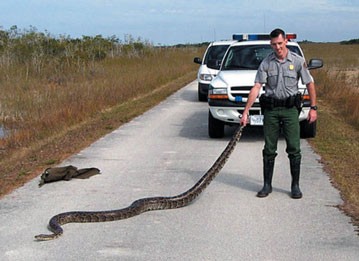
Invasive Burmese python in the Florida Everglades
Invasive species impact humans too. They’re very expensive – each year local, state, and national governments along with private homeowners spend money to remove stubborn exotic plants or eliminate pesky wildlife. Believe it or not, the annual estimated cost in the United States of invasive species control is about 120 billion dollars per year!
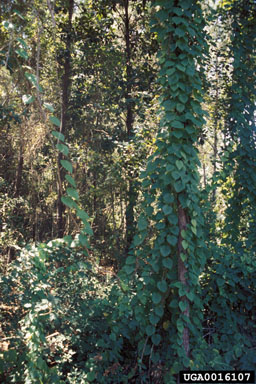
Air potato infestation: This exotic plant is a problem in many Manatee County preserves and each year the Natural Resources Department relies on volunteers to help remove these exotic invaders. Air potato grows quickly, over taking all the native plants in its path, and produces a great number of potatoes on one vine to seed new plants. Left unchecked it will quickly overgrow an area and shade out the native plants. Photo by Forestry Images
Many of the exotic invaders in Florida are plants or invertebrates (animals like snails and insects), however recently the state has seen its share of larger wildlife invaders including pythons, Cuban tree frogs, lionfish, and even coyotes. There are even a few types of invasive birds, such as the Muscovy duck, house sparrow and European starling. Here in Manatee County, we have seen an increasing number of one particular invasive bird, the easily identifiable and often comical Monk Parakeet, Myiopsitta monachus.
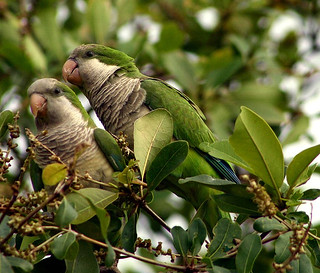
Monk Parakeets. Photo by Maureen Leong-Kee
The monk, or quaker, parakeet appeared in Florida in the 1960s. It is an extremely unique type of parrot as it is one of the few that actually builds its own nest out of sticks and twigs, rather than utilize a cavity in a tree. Because of this unique adaptation the bird has quickly managed to colonize much of Florida; it is currently present in over 50 of Florida’s 67 counties. The little green birds are, like most parrots, quite clever and have adapted to using many of our manmade structures for their nesting sites. Unfortunately, one of their favorite places to build their homes is in and around electrical equipment and telecommunication towers, often providing problems for local power companies.

A monk parakeet nest on a power station. Photo by Florida Power and Light (FPL)
As with many exotic invasive species, Florida’s warm tropical weather has proved to be a great attraction to the little birds and has benefited them greatly helping their numbers to swell. However, they are not the first parrots to have lived in Florida and have rapidly assumed a niche left vacant by the disappearance of the United States’ only native parrot, the Carolina conure. These birds lived in the same areas in which the monk parakeets have rapidly colonized and feast upon many of the same foods. A number of factors led to their demise, most notably hunting for food and for their beautiful plumage, farmers who killed them because they considered them to be a crop pest, and the destruction of the trees in which they nested. The monk parakeets on the other hand survive and flourish due to their ability to create their own nests.
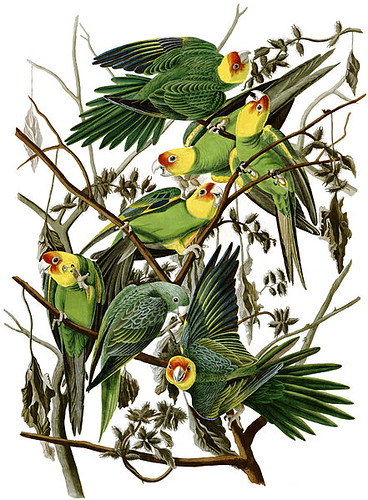
Carolina conure (now extinct) drawing by John James Audubon
The modern parakeets are an excellent example of how one invasive exotic can move in and quickly take over another species’ role, whether it is living or already extinct, and flourish when there are no environmental factors to help control it. Organizations such as Manatee County’s Natural Resources Department, the Tampa Bay Estuary Program, Sarasota Bay Estuary Program, and Charlotte Harbor Estuary Program work to help educate the public about the importance of exotic invasive species control and eradication. They also stage a number of volunteer workdays to visit public natural lands and help remove exotic species. You can help by making sure your yard is free of exotic invasives or by participating in exotic based volunteer workdays in your home area.
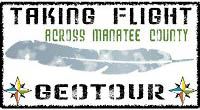
Visit the sites along the Taking Flight GeoTour (TFGT) and learn about Manatee County's wild spaces and the amazing feathered friends that live in them. Along the way, you will be challenged to become a citizen scientist, a preserve ranger, a detective, a historian, an excellent geocacher. Caches are located in birding hot spots throughout Manatee County's publicly accessible conservation Preserves. Each one highlights a specific bird species or aspect of bird life providing you with opportunities to learn more about these creatures and what we can do to help them survive. Caches also focus on protecting the region's waterways, bays, natural watersheds, and habitat areas for many of our area's feathered friends.
The Taking Flight GeoTour launched August 20, 2012 and includes 18 caches within Manatee County.
To be eligible to receive a Taking Flight GeoTour prize tag, geocachers must complete the activities in this survey for at least 12 finds on the tour. Keep this survey open in your browser, only click submit when at least 12 finds have been completed. Survey responses will be automatically sent to Manatee County staff. Prize tags can be redeemed on Saturday mornings from 9am - 12pm at The NEST at Robinson Preserve located at 840 99th St NW, Bradenton, FL 34209. If you are unable to collect your prize tag in person, please contact ecoevents@mymanatee.org to arrange for your tag to be sent in the mail. Tags will be available while supplies last.
Thank you for assisting with the Taking Flight GeoTour: